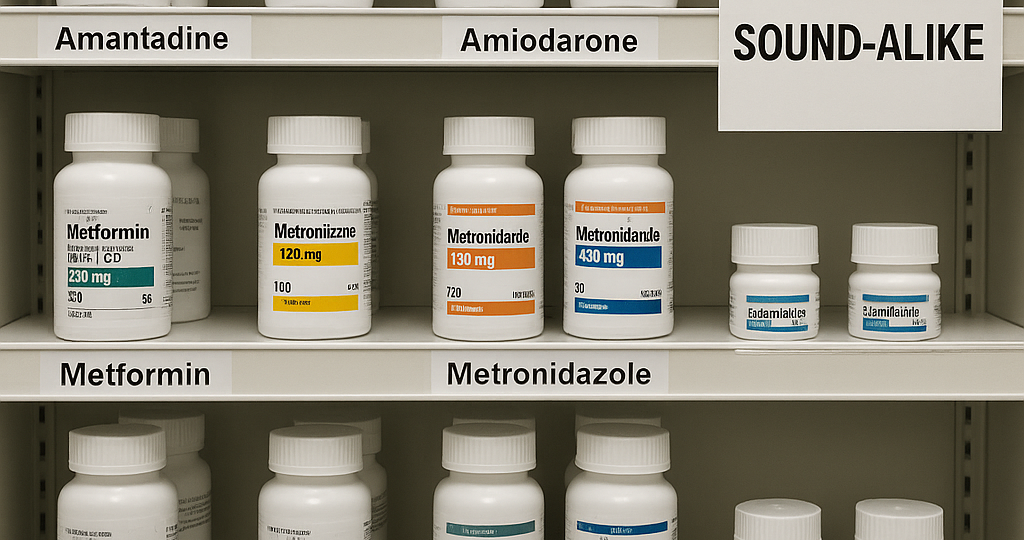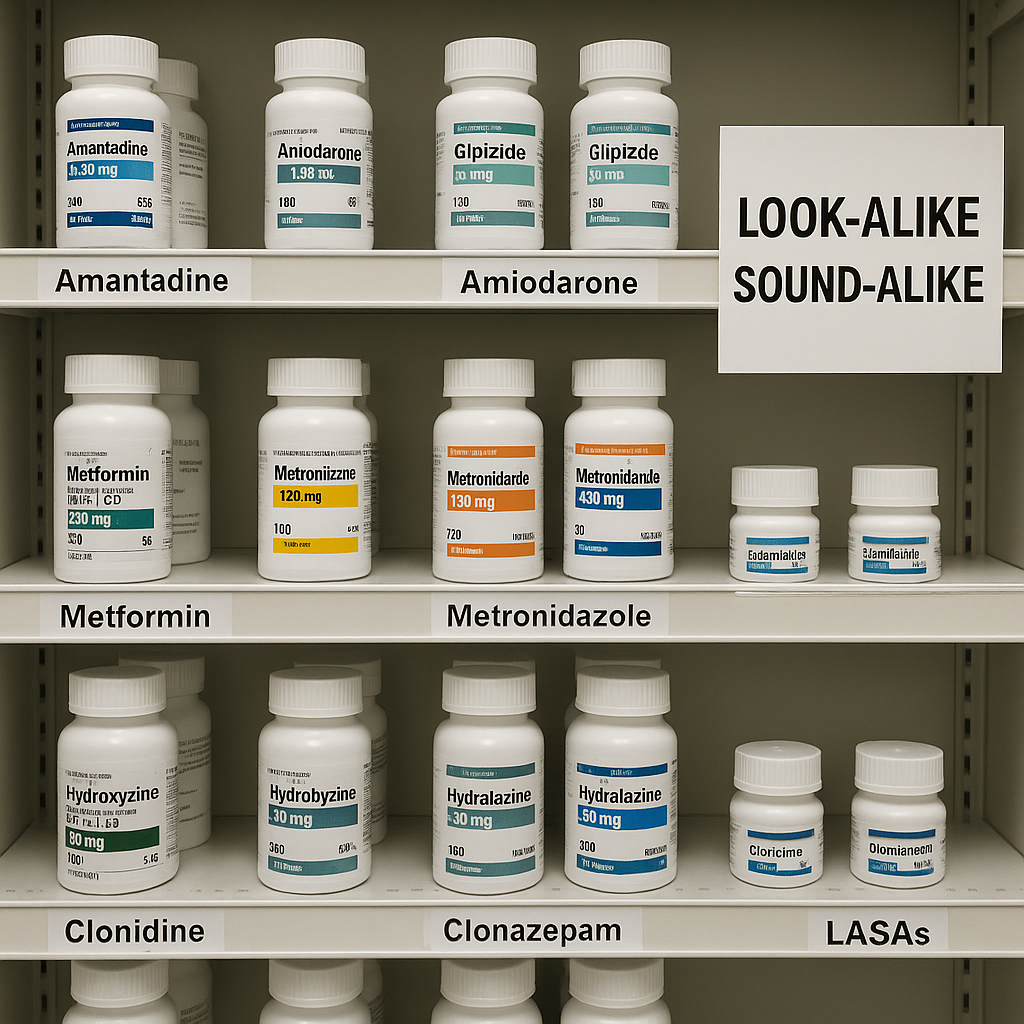07 July 2025
Category: Patient Safety Initiatives I
Clinical Practice & Prescribing Safety I
Medication Safety
Written By: Dr. Srivatsan Suresh (PharmD)

Around the world, Look Alike & Sound Alike drugs (LASA) are a known source of preventable medication errors. When medications with similar names, packaging, or articulation are mistakenly prescribed, dispensed, or administered, these mistakes happen. The results include life-threatening adverse events or therapeutic failure.
Despite increased use of digital technologies, LASA-related events remain common. A 2021 systematic review reported that medication name confusion is still a major contributor to wrong-drug errors globally. Reducing LASA errors requires system-wide vigilance, training, and safety design in addition to improved labeling.
Case Report Highlights
Tanzania (2024)
In a documented case from Tanzania, a 37-year-old woman undergoing cesarean delivery received tranexamic acid (TXA) intrathecally instead of bupivacaine. It is because the ampoules look similar and are stored in the same surgical drug tray. So within 21 hours, the patient experienced a seizure, severe autonomic disturbances,, and death.
Egypt (2023)
Another case from Egypt involved a 31-year-old male who received 400 mg of TXA intrathecally during surgery. Unlike most such cases, he survived after performing Cerebrospinal fluid (CSF) lavage and ICU care. This highlights the urgent need for redesigning ampoules with distinct visuals.
USA
In multiple U.S. hospitals, Hydroxyzine (an antihistamine) was mistakenly given in place of Hydralazine (an antihypertensive). Both drugs were often stored next to each other in ADCs (automated dispensing cabinets). This prompted the ISMP to recommend separate storage, TallMan lettering, and barcode verification protocols for high-alert LASA medications.
Canada
The Institute for Safe Medication Practices Canada (ISMP Canada) has documented four separate incidents in which lamotrigine (LAMICTAL) was confused with three entirely different medications. In these cases, patients were inadvertently dispensed
Lamivudine (HEPTOVIR), is an antiretroviral agent, Terbinafine HCl (LAMISIL) is an antifungal, and Liothyronine (CYTOMEL) is a thyroid hormone replacement
Each mix-up arises from striking similarities in drug names or packaging, resulting in potentially serious clinical consequences. These reports underscore the imperative for heightened pharmacy verification steps such as Tall Man lettering, barcode scanning, and double‑check systems to catch LASA errors before they reach the patient.
Indian Generic Market as a potential source
The Indian generic pharmaceutical market has inadvertently become a significant source of Look-Alike Sound-Alike (LASA) medication errors. With thousands of manufacturers producing similar formulations under distinct brand names, the risk of phonetic and orthographic confusion is significant. Many generic brands adopt names that closely resemble existing products in an attempt to gain market traction, most of the time without adequate regulatory screening for name uniqueness. This leads to confusion at the prescribing, dispensing, and administration stages, particularly in resource-limited settings where electronic verification tools may be lacking.
Global Trends
According to a 2023 Australian study, LASA drug mix-ups, particularly involving injectables like TXA, dopamine, and local anesthetics, were responsible for 6-15% of preoperative incidents. The study recommended segregated storage procedures and clearer ampoule labeling.
The Lancet (2024) suggested regulatory reform and standardized drug labeling in India. Due to the pharmaceutical industry’s widespread fragmentation, local brands with phonetically similar names were frequently confused, particularly in settings involving oncology and anesthesia.
Tall Man lettering and brand screening should be implemented nationwide immediately after researchers in Thailand examined more than 18,000 brand names and discovered frequent orthographic and phonetic overlaps among commonly prescribed drugs.
Technology-Driven Innovations
AI-Based Pill Recognition
A 2022 AI model, PIMA (Pill Identification via Matching Algorithm), used deep learning and contrastive learning to match pill images to prescriptions. It improved correct identification rates from 19% (human-only review) to 47% using machine learning.
Automated Dispensing Cabinets (ADC)
Selection errors are greatly decreased by modern ADCs when they are set up with barcode scanning and optimal LASA drug placement. According to a 2021 ISMP bulletin, 12% of LASA near-misses were caused by improper cabinet layouts
System Factors behind LASA Errors
A medication error rarely happens due to oversight. The Swiss Cheese Model explains that layers of system failures—like poor labeling, fatigue, or sound-alike names align to allow such errors through.
Some key contributing factors are
- Similar packaging or ampoule colour
- Inadequate barcode scanning
- Distractions or rushed environments
- Lack of Tall Man Lettering
- Verbal miscommunication or illegible prescriptions
In busy surgical or emergency settings, these issues compound and lead to fatal outcomes.
Prevention Strategies
Tall Man Lettering
Used to highlight differences in similar drug names (eg- vincristine vs. vinblastine), this has been endorsed by the FDA and implemented in many EMR systems.
Barcode and Scanning
Incorporating barcode technology for verification during dispensing and administration reduces manual selection errors significantly.
AI verification tools
Machine learning models like PIMA and image-matching algorithms are being piloted to verify pills, especially in outpatient or home care settings.
Physical separation of LASA drugs
LASA-prone medications need to be kept physically apart, particularly in intensive care units, emergency rooms, and operating rooms.
Standardized protocols and training
- Verifying twice while preparing and administering
- Regular training includes LASA case studies
- Simulation studies are required when approving new drugs
Regulatory and Institutional Efforts
WHO (2023)
Issued updated safety alerts following a cluster of fatal TXA intrathecal administrations in low-resource settings.
FDA (2022)
Reinforced the use of Name Simulation Studies as a regulatory step before drug approval, aimed at preventing new LASA names from entering the market
ISMP (2021-2023)
Maintains publishing and updating LASA watch lists, near-miss reports, and instructions for reorganizing medicine storage and ampoule labeling.
JCI’s Role in LASA Error Prevention
The Joint Commission International (JCI) is a globally recognized healthcare accreditation body that sets rigorous standards for patient safety and quality of care. It supports hospitals and health systems worldwide in improving clinical practices, including medication safety and LASA error prevention.
International Patient Safety Goals (IPSG 3) included standard practice to improve the safety of high-alert medications under this goal; JCI specifically emphasizes the identification and management of LASA medications.
Accredited hospitals are required to maintain an active list of LASA drugs, assess risk potential, and implement preventive strategies such as the following:
- Tall Man lettering
- Color-coded labels
- Separate storage
- Staff education and the LASA drill
JCI mandates that organizations implement Medication Management and Use (MMU) protocols, which include:
- A documented LASA risk reduction strategy
- Use of double-verification systems in dispensing and administration
- Periodic audits and incident tracking of LASA errors
JCI provides toolkits and reference guidelines for identifying LASA pairs during formulary reviews and encourages the use of international LASA watch lists
Conclusion
One of the biggest risks to patient safety is still LASA medication errors, particularly in high-stakes settings like critical care, oncology, and surgery. These errors could be reduced by combining smart storage systems, training, modern technologies, and regulatory reform.
The key lies in redundancy: no single tool or strategy is enough. Systems need to be built to fail safely, identifying mistakes before they affect the patient. We can eliminate LASA errors with the correct tool investment and attention to detail.
References
Bryan R, Aronson JK, Williams AJ, Jordan S. A systematic literature review of LASA error interventions. British Journal of Clinical Pharmacology, 2020 Nov 16; 87(2):336–51.
Samuel RO, Adonicam V, Mgaya AH, Accidental intrathecal tranexamic acid injection during cesarean section: A case report. Case Reports in Anesthesiology, 2024 Jan 1; 2024(1).
Harby SA, Kohaf NA. Accidental intrathecal injection of tranexamic acid: a case report. Journal of Medical Case Reports, 2023 Feb 16; 17(1).
Hydralazine, Hydroxyzine Confused Again, America’s PHARMACIST | October 2016, Institute for Safe Medication Practices (ISMP), https://www.ncpa.co/issues/APOCT16-MedSafety.pdf
Hydroxyzine and Hydralazine Mix-Ups, Pennsylvania Patient Safety Advisory, Patient Safety Authority, https://patientsafety.pa.gov/ADVISORIES/Pages/200606_21.aspx
Ryan AN, Robertson KL, Glass BD. Look-Alike, Sound-Alike Medication Perioperative Incidents in a Regional Australian Hospital: Assessment using a Novel Medication Safety Culture Assessment Tool. International Journal for Quality in Health Care. 2025 Mar 3;
Neelakantan M, Association for Socially Applicable Research (ASAR), Pune, Maharashtra, India, Department of Community Medicine, Maulana Azad Medical College, New Delhi, India, Independent Economist, India. Look-alike, sound-alike (LASA) drugs in India. Vol. 26, the Lancet Regional Health – Southeast Asia, 2024, p. 100425
Wikipedia contributors, Tall Man lettering, Wikipedia, 2024
Nguyen TT, Nguyen HD, Nguyen TH, Pham HH, Ide I, Nguyen PL, A Novel Approach for Pill-Prescription Matching with GNN Assistance and Contrastive Learning, arXiv.org. 2022
Acute care, ECRI, and ISMP, 2024
Meyer TA, McAllister RK. Medication Errors Related to Look-Alike, Sound-Alike Drugs—How Big is the Problem and What Progress is Being Made? Vol. 38, APSF Newsletter. 2023 p. 2–49
WHO. (2023). Intrathecal TXA Global Alert
Office of the Commissioner, Modeling & Simulation at FDA [Internet], U.S. Food And Drug Administration. 2022.
Dhande PP, Mule AV, Chaudhari AP. Retrospective analysis of look-alike and sound-alike drug incidents in a tertiary care hospital. Indian Journal of Pharmacy Practice 2021 Apr 15;14(2):114–7.
Standards Interpretation FAQs, IPSG-3, Joint Commission International, https://www.jointcommissioninternational.org/-/media/jci/jci-documents/contact-us/submit-a-jci-standards-interpretation-question/jci_standards_interpretation_faqs.pdf
Multiple Reports of Confusion Between Lamotrigine (LAMICTAL®) and Products with ‘sound alike’ / ‘look alike’ Names, ISMP Canada Safety Bulletin, ISMP Canada, December 2001, Vol 1, Issue 3

Dr. Srivatsan Suresh is a Pharm.D. graduate with a focused background in clinical research, pharmacovigilance, and regulatory science. Adept at synthesizing clinical data into clear, compliant medical content. Passionate about medical writing as a strategic tool to support regulatory submissions, healthcare communication, and scientific publications in a fast-paced industry setting.

